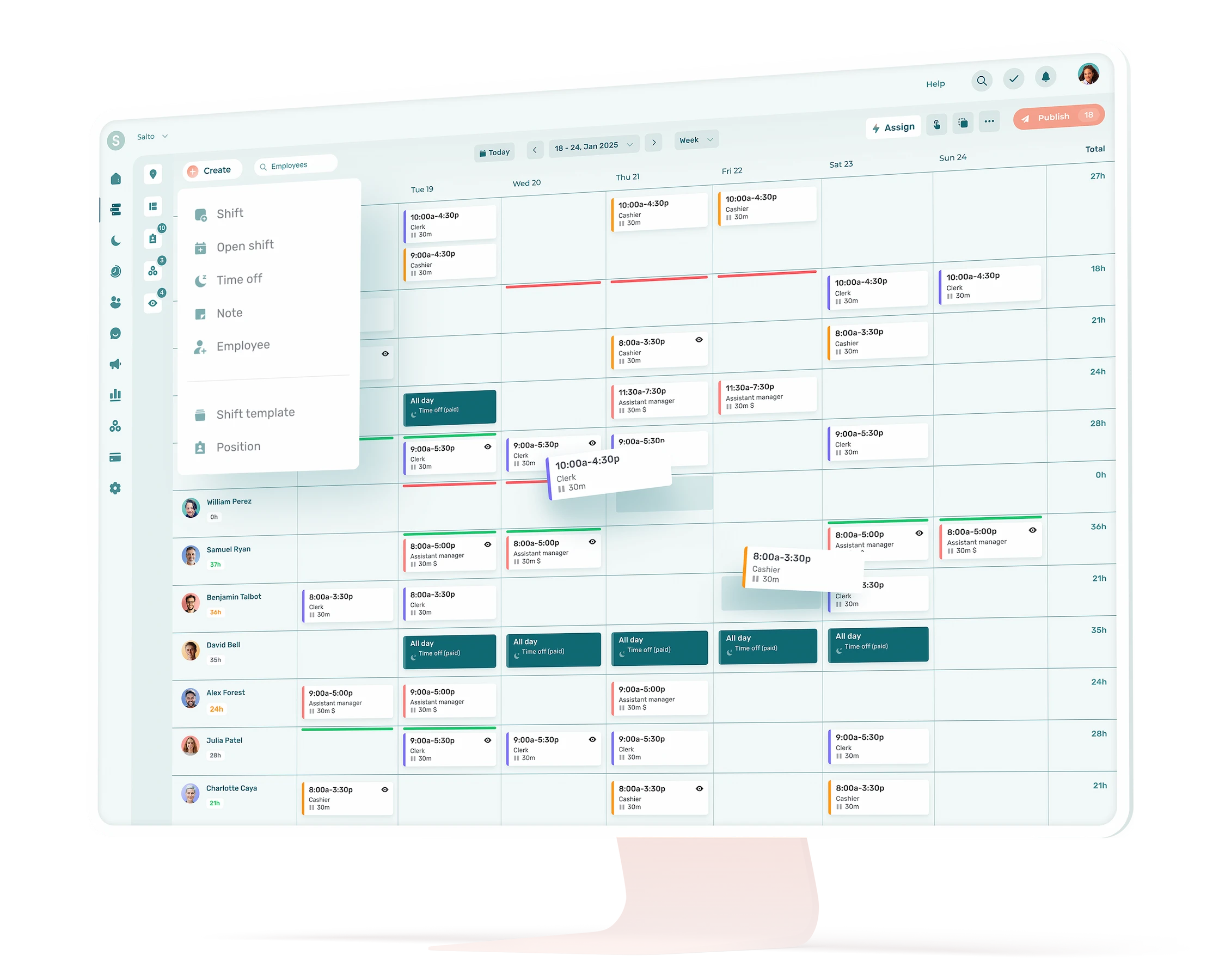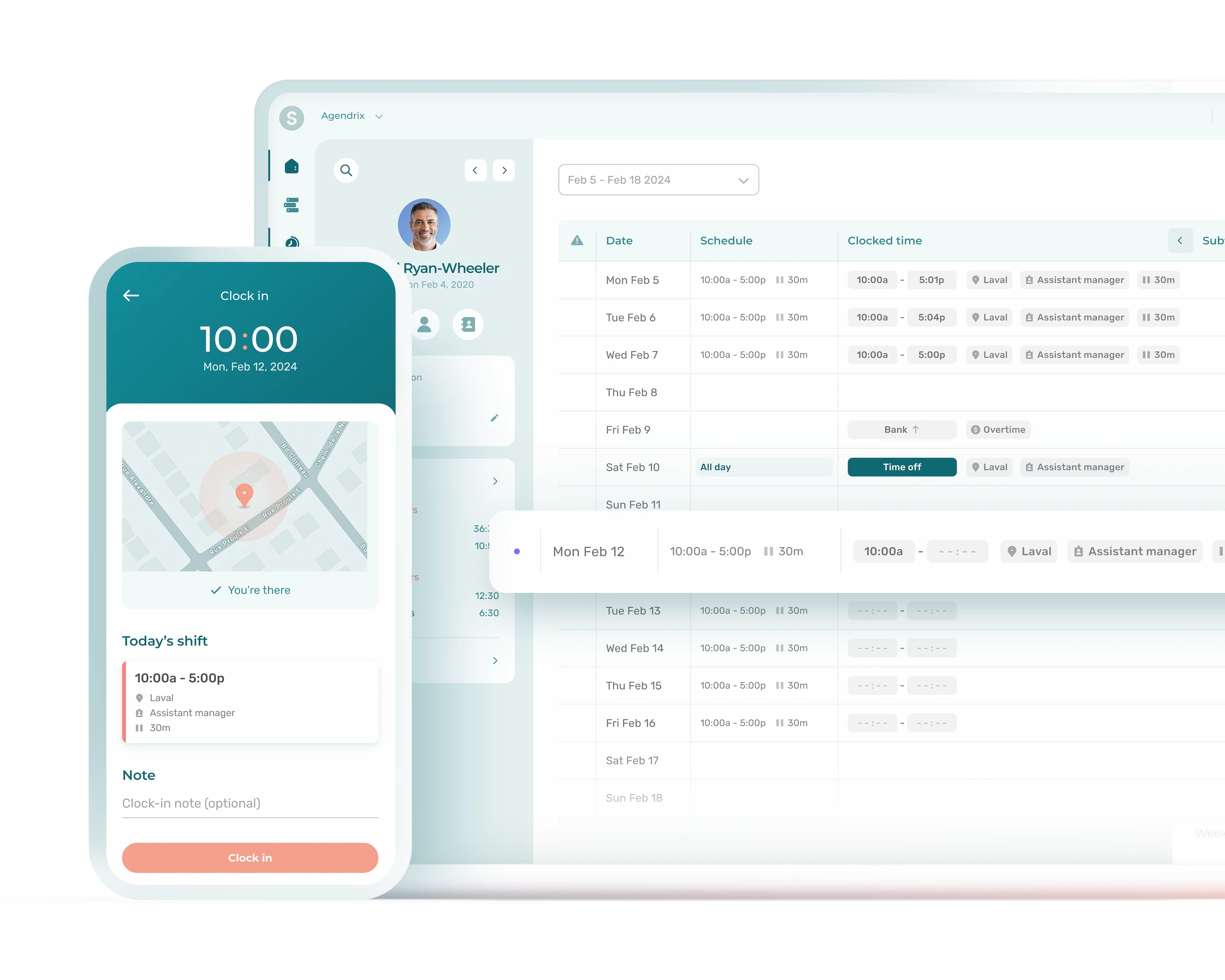Work breaks are essential for the well-being of employees and to comply with existing labor laws.
As an employer, it’s your responsibility to ensure that you offer break times in accordance with current legislation. And let’s face it, your employees need them to be truly productive at work.
Taking regular breaks increases employee productivity and job satisfaction, reduces the risk of burnout and stress, and improves employee well-being.
94% of employees say they return to work with a better outlook after taking a break, according to a 2022 study.
Rest periods are therefore as beneficial to employees as they are to the company. They also provide an important moment that helps solidify bonds between staff members and contribute positively to their experience within the company.
In this article, you will learn more about:
- Employers’ legal obligations: length of work breaks, exceptions, remuneration, and consequences of non-compliance;
- The benefits of providing employees with break time;
- How to optimize and ensure that employees take their mandatory breaks; and
- A foolproof tool to facilitate break time management.
Mandatory Work Breaks: What Does the Law Say?
The law clearly defines employers’ obligations when it comes to breaks.
On the other hand, it’s important to note that the laws put in place are designed to ensure minimum standards. As such, they are not necessarily the best practices to follow. Most employers offer more break time than the law allows.
💡 Some employers must also comply with collective agreements or contractual provisions that differ from what the law stipulates, as is often the case in the healthcare or seniors’ residences sectors, for example.
How Long Is the Break During the Working Day?
Break Time in Quebec
In Quebec, employers are required to offer their employees a 30-minute (unpaid) meal break after 5 consecutive hours of work. During this break, the employee is not deemed to be available to the employer. They can therefore spend their time as they wish. This break cannot be split.
Employers can determine when breaks are taken, or leave them to the discretion of employees. Generally speaking, the conditions surrounding breaks are identified in employment contracts.
In all cases, the length of breaks required for employees to complete their tasks and rest adequately depends largely on the industry. For example, employees in a restaurant will not have the same reality as those in a call center or pharmacy.
Are the Rules on Break Times Different for Night Shifts?
Break times for night shifts are governed by the same laws as for day or evening shifts, both in Quebec and in France. If additional break times are offered by the employer, they must be defined in the employment contract or agreement and remunerated.
To ensure employee productivity and efficiency, employers should offer extra breaks, especially during night shifts. These shifts are more difficult for employees, and offering more rest time can help them stay more focused and motivated.
Paying for Work Breaks
Meal breaks are not paid in either France or Quebec. However, if the employer decides to offer additional break time, it must be paid for.
In Quebec, employers are not required to offer additional break times, but it is a widespread practice given all the associated benefits. Employees are generally not allowed to leave early just because they haven’t taken a break, since this time is paid for by the employer. The break must therefore be taken during the shift to allow the employee to rest.
What Happens if an Employer Doesn’t Respect Break Times?
If an employer does not respect the duration of the break to which employees are entitled, they can lodge a complaint with the competent authorities.
In Quebec, employees can contact the CNESST. In France, they must lodge a complaint with the Conseil des Prud’hommes (industrial tribunal), and may report the matter to the Labour Inspectorate.
Can an Employer Deny Employees a Break?
Employers are required by law to let their employees take a meal break after a certain number of consecutive working hours. They can leave it up to employees to decide when to take their break, or set a specific time for them to do so.
However, employers may refuse to allow an employee to take a coffee break, since this is not required by law. They may not, however, prevent an employee from using the bathroom.
Break Time: A Productivity Factor
Offering your employees more breaks and rest time shows that you care about their well-being at work. It’s also a widespread practice that contributes directly to your company’s reputation.
6 Benefits of Taking Work Breaks
There are many benefits to taking a break at work. These moments of rest have positive repercussions for employees and employers alike.
So it’s to your advantage to ensure that your employees take regular breaks.
Here are 6 benefits of taking breaks at work.
1. Breaks Reduce Stress
Breaks allow employees to decompress and relieve stress at work. Customer service and the quality of employees’ work performance improve when they can take breaks to clear their minds.
For example, if an employee has just had to deal with a difficult customer, it’s beneficial for them to decompress. They’ll come back calmer and be able to offer better service to other customers.
2. Lack of Breaks Contributes to Employee Burnout
Taking breaks allows employees to rest and improve their well-being, helping to reduce the risks associated with burnout.
41% of Canadians aged 18 to 34 claim to be suffering from burnout, according to a 2021 study.
To maximize the benefits of breaks, offer your employees a calm and cozy break room. For example, make sure that your break room is well decorated, and provide comfortable chairs. You can also encourage your team members to take active breaks and enjoy the outdoors whenever possible.
3. Breaks Provide an Opportunity to Socialize With Colleagues
Break times allow employees to socialize with each other. The better the relations between your employees, the better the team cohesion.
A closer-knit team with employees who have a strong sense of belonging helps to achieve objectives more quickly and contributes to building an attractive corporate culture.
4. Work Breaks Prevent Eye Strain
If your employees work on computers, as they might in a call center, it’s important that they have breaks away from their screen. This will allow them to rest their eyes and prevent certain health problems.
5. Rested Employees Are More Productive
When employees are more rested, they are more productive at work. In fact, one study has shown that an individual’s performance and productivity drop drastically when the brain becomes too accustomed to performing the same task. Taking short breaks allows employees to return to work more focused.
As a manager, don’t hesitate to lead by example by taking your own breaks. Make sure your employees see that you do so regularly. You can also determine the time of your breaks and note them in your employees’ schedules. In this way, you can ensure that you have enough staff and that they can rest during their shift.
6. Break Time Is Good for Employees’ Mental Health
Breaks allow your employees to take a step back from their work, vent their frustrations, and even regain motivation. They also reduce mental fatigue.
Offering more breaks helps improve your employees’ mental health. It also shows that you care about their well-being at work.
Tips and Tricks for Optimizing Breaks
There’s no magic formula when it comes to breaks. Every company has different needs, and not all employees have the same needs either.
Some experts suggest taking shorter, more frequent breaks to minimize mental fatigue. For example, employees could take a 5-minute break every working hour.
Others prefer longer breaks that allow employees to really unwind. Choose the structure that best suits your team members and your company.
Try to let your employees choose the right time for their break whenever possible. This way, you ensure that you don’t interrupt their workflow or their productivity momentum.
The important thing is to offer your employees the opportunity to take breaks, and to make sure they really take them.
What Are the Signs That Your Employees Should Take a Break?
- The employee is hungry and needs a snack
- The employee is no longer able to concentrate effectively
- The employee needs to stretch or move
- The employee feels frustrated
- The employee needs to take a step back
Encourage your employees to take short breaks when any of these signs occur. They’ll come back to work more motivated and productive, while feeling that you really do care about their well-being.
Use Time and Attendance Software to Simplify Break Management
The most effective way to ensure that your employees take their breaks—and that they do so at the right time—is to schedule them.
With time and attendance software like Agendrix, it’s easy to do. You can add break automation parameters according to your needs and the legislation or constraints to comply with. You can determine the duration of breaks, whether they are paid or unpaid, to which type of shift they apply, and even the branch concerned.
Once the settings have been saved, the applicable breaks will be added directly to your employees’ shifts. This way, you’ll always be sure to comply not only with the various laws in place, but also with the provisions of agreements and employee contracts.
For example, you could determine that employees who work a 6-hour shift are entitled to 30 minutes of unpaid meal break and 15 minutes of paid break. The actual working time would then be 5.5 hours.
Employees who work 8-hour shifts might be entitled to 30 minutes of unpaid meal break and 2 x 15-minute paid breaks. The actual working time would then be 7.5 hours.
Simplified Time and Attendance
With time and attendance software, employees clock in, take breaks, and clock out directly from the software. As a result, timesheets are filled in automatically and working hours are calculated quickly.
For example, Martine, manager at the Les Enfants Terribles restaurant, used to spend 3 hours a week validating timesheets, whereas with Agendrix, this task only takes 30 minutes.
Timesheet and payroll errors are also reduced. Paid and unpaid breaks are calculated automatically, saving managers an enormous amount of time.
Conclusion
Nobody can stay 100% focused on their work for a full day. Your employees need breaks to be more productive, motivated, and focused.
Go beyond what is required by law and, at the very least, allow your employees to take a morning break, a lunch break, and an afternoon break.
Don’t hesitate to note work breaks directly in your employees’ schedules, so they know exactly what they’re entitled to. Make sure they can take their breaks even at busy times. The benefits of breaks are too numerous to ignore.
How Does Break Time Work?
Break times at work are determined by the laws in force. It may therefore differ from one territory to another.
Break times at work also depend on the employment contracts or collective agreements in place. Employee rights and conditions may therefore vary from one company to another.
Are Breaks Compulsory at Work?
Breaks at work are not always compulsory. In France and Quebec, for example, employers are required to offer a meal break after a certain number of hours worked. However, this break is unpaid.
Employers are not required to offer employees a coffee break, neither in Quebec nor in France.
In practice, most employers offer coffee breaks to their employees, as these are beneficial to their productivity and help limit risks of burnout.











